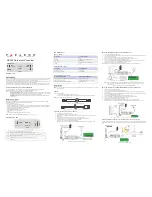
Page 2
©
2017 Sensata Technologies
Introduction
1.1
How the MS-PAE Series Inverter/Charger Works
There are two main modes of operation associated with the MS-PAE inverter/charger:
Inverter Mode
When the inverter is properly connected to batteries and turned on, the direct current (DC) from
the batteries is transformed into a pure sine wave alternating current (AC). This AC is similar to
the voltage provided by your utility, and is used to power the electrical appliances (i.e., AC loads)
connected to the inverter’s output.
Standby Mode
When an external source of AC power (e.g., utility power or generator) is connected and quali
fi
ed
on the inverter’s AC input, it operates in Standby mode. In Standby mode, the unit operates as a
battery charger to convert the incoming AC power into DC power to recharge the batteries; while
at the same time, an internal AC transfer relay is automatically closed and passes the incoming AC
power directly to the inverter’s output to continue powering the connected electrical appliances.
1.1.1 Inverter Applications for Permanent Installations
An inverter can be used for backup power in a permanent location that normally uses utility power,
such as a home or of
fi
ce. When utility power is available, the inverter keeps the batteries charged.
When the utility power fails, the inverter comes on automatically to supply AC power to your home
or of
fi
ce during the power failure. For a home or business, reliable backup power is needed to
prevent lost computer data, or to maintain lights and keep food fresh in the refrigerator/freezer.
In some areas, where utility power is not available, the inverter can be used in a standalone
renewable power system. The inverter enables AC electrical appliances to be run from the storage
battery bank. When the battery bank becomes discharged, either renewable DC sources (solar,
wind, or hydropower) can be used to recharge the batteries, or a generator can be connected to
the inverter to power the system while the batteries recharge.
1.1.2 Advantages of a Pure Sine Wave Inverter
Today’s inverters come in three basic output waveforms: square wave, modi
fi
ed sine wave (which
is actually a modi
fi
ed square wave), and pure sine wave (see Figure C-1 in Appendix C). Modi
fi
ed
sine wave inverters approximate a pure sine wave form and will run most appliances (see also
Section C-1 “Appliance Power Consumption” in Appendix C) and electronics without any problems.
These inverters are less expensive, and therefore, offer a viable alternative to more expensive
pure sine inverters.
The output of the MS-PAE Series, which is a pure sine wave inverter, is equal to or in many cases,
better than the utility power used in your home. Virtually any electronic device will operate from
a pure sine wave inverter. Motors run cooler, microwaves usually cook faster, and clocks keep
better time just to name a few examples. Without compromising quality or performance, the MS-
PAE Series provides you with all the advantages of a pure sine wave inverter at a much lower
cost than many on the market.
The MS-PAE Series is built on the same platform as our popular MS Series which helps reduce
cost by using standard parts/accessories across many models. Magnum accessories such as the
Advanced Remote Control (ME-ARC), Router (ME-RTR), Automatic Generator Start-Networked
(ME-AGS-N), and Battery Monitor Kit (ME-BMK) can be used. See Section A-2 “Optional Equipment
and Accessories” for more information on these products.
Info:
For the MS-PAE Series inverter/charger to perform optimally, a minimum battery
bank of 200 AH is recommended for moderate loads (<1000W), and greater than 400
AH for heavy loads (
≥
1000W).












































